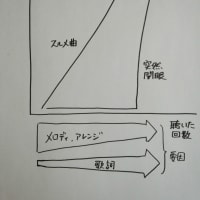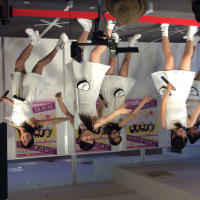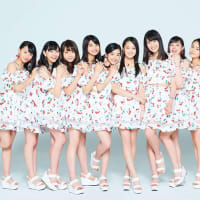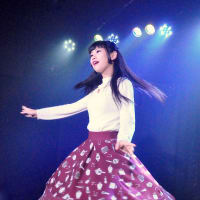http://search.japantimes.co.jp/cgi-bin/fm20101231a1.html
2010's many charts tell a confusing tale
Reason behind sales may say more about urban-rural divide than musical genius
By IAN MARTIN
Special to The Japan Times
As seems to be becoming commonplace with these end-of-year roundups, the big music story was once again the rise (and rise) of AKB48 and their rapidly multiplying sister groups, SKE48 (named after their home at Nagoya's Sunshine Sakae building), NMB48 (after Namba in Osaka) and "mature" proto-porn, postgraduation dumping ground SDN48 (from the group's Saturday night live time slot).
Next year, we can maybe expect SAP48, named both for the city of Sapporo and in tribute to the poor saps who are bankrolling producer Yasushi Akimoto's empire. And if anyone can think of a handy abbreviation for a Fukuoka-based group, please let us know. In fact, these groups are proliferating at such a rate that it's estimated by 2014, Akimoto will be employing more teenage girls than McDonald's, and by 2020 he will overtake the entire Southeast Asian sex industry.
If there was ever any remaining doubt that it is sex, rather than music, that is the primary engine propelling the success of the Akimoto project, the music videos for "Ponytail to Chuchu" and "Heavy Rotation," with their creepy juxtaposition of playground innocence and voyeuristic teasing, must surely put that to rest. Next to the complex sexual doublethink AKB48 ask of their fans, the re-emergence of ex-member Rina Nakanishi as a straightforward, honest-to-goodness porn star in July seemed almost endearingly old fashioned.
For anyone looking to enjoy their female pop stars without troubling their inner Humbert Humbert, crack squads of long-legged, slick, aggressively modern, electropop beauties were being beamed in from South Korea across the Sea of Japan in chart-bothering numbers, with Kara, Girls Generation, Brown Eyed Girls and more breaking into the Japanese mainstream.
And insofar as any of these groups have anything to do with music in the first place, what is striking about the current Korean invasion is just how parochial their Japanese competitors now sound in comparison. Minimize your browser window for a moment while ogling AKB48's undeveloped teenage bodies, and what's left is music that hasn't changed in any significant way since the peak sales period of the Japanese pop industry in about 1997.
Looking at Japanese chart-rankings company Oricon's Top 10 singles of the year, the results show, in addition to four AKB48 tracks, five songs by boy band Arashi and one by Kat-tun, both from the stable of pop factory Johnny & Associates, who seem to have been squatting at or around the top of the Oricon rankings since before the Battle of Sekigahara.
Of course, any news of Oricon rankings allows us to play every Japanese music industry observer's favorite game of spot the difference with a quick glance at some of the other rankings out there, including Tower Records, MTV, USEN (cable radio and media contents group), iTunes, Recochoku (mobile downloads and ringtones), and the Joysound and UGA karaoke rankings. They reveal a rather different picture of Japan's musical landscape.
The AKB girls' popularity appears to be more or less universal across the board, but the Johnny's artists are far more scarce, with faux-alternative pop idol Kaela Kimura reigning over the iTunes Top 10 with her songs "Butterfly" and "Ring a Ding Dong," while shout-outs should also go to blues rocker Superfly and hip-hop duo Hilchryme.
For mobile-phone users, the undisputed star of the year, with mass dominance across all audio categories, has been the singer Kana Nishino, whose song "Aitakute Aitakute" is doubtless annoying people in classrooms, on trains and in libraries countrywide at this very moment thanks to its popularity as a ringtone. Recochoku also reveals that in video downloads, Kara in particular are giving AKB48 a serious run for their money.
Finally, the karaoke rankings again show Kaela Kimura and Hilchryme in strong positions, although hip-hop dentists GReeeeN's "Kiseki" and anime singer Yoko Takahashi's "Evangelion" theme rule the roost.
So what does any of this mean? Well, assuming that Oricon's results are more or less accurate, as I'm sure The Japan Times' lawyers will be assuring me is the case, we can probably draw a few conclusions here.
First, AKB48's popularity has gone far beyond their Akihabara otaku roots. More or less ordinary guys, and most probably young girls as well, are buying their music in large quantities throughout the country.
Second, there is both an age gap and an urban-rural divide in play with these results. Internet and mobile downloads tend to skew young, and karaoke results will probably skew urban. The astonishing performance of Arashi could at least in part be down to very high sales from older audiences in countryside areas, which at least seems to chime with Johnny's artists' well-known popularity with middle-aged women, while Kana Nishino's total dominance with mobile- phone junkies (young and female), suggests she may very well be the new Ayumi Hamasaki.
Finally, the popularity of Kara and Girls Generation in the mobile-video download charts suggests that the stereotype of Japan as a nation obsessed with servile, underdeveloped teenage beauty is being challenged. When given a more mature, sexier alternative, the image sells.
But while all of these pieces of production-line pop confectionary tear each other apart over the decaying corpse of the Japanese music industry on behalf of their desperate corporate masters, in the end, new ideas are what will save music — and as usual, these ideas are coming from anywhere but the music industry establishment.
Indie-rock band Andymori, whose album "Fanfare to Nekkyo" managed to graze the charts early in the year, are bringing in huge crowds right now, and to achieve that level of popularity without the aid of a major label shows that, to some at least, tunes still matter. Credit should also go to Andymori's distributor, Boundee, a company whose integrated approach to promotion could be at the forefront of a move that will eventually cut labels out of the whole distribution chain (while conveniently ensuring the initial costs still largely remain with the artists).
Similarly, the meteoric rise of punk- rock techno-geeks Shinsei Kamattechan, whose popularity was largely spread via video-sharing website Nico Nico Douga, shows that while major labels are still falling over themselves, Keystone Kops style, trying to erase their own artists' music videos from the Web, the digital arena is wide open for those with the skill to exploit it.
Beginning next year, Ian Martin will start writing a column on the fourth week of every month for The Japan Times music page.
2010's many charts tell a confusing tale
Reason behind sales may say more about urban-rural divide than musical genius
By IAN MARTIN
Special to The Japan Times
As seems to be becoming commonplace with these end-of-year roundups, the big music story was once again the rise (and rise) of AKB48 and their rapidly multiplying sister groups, SKE48 (named after their home at Nagoya's Sunshine Sakae building), NMB48 (after Namba in Osaka) and "mature" proto-porn, postgraduation dumping ground SDN48 (from the group's Saturday night live time slot).
Next year, we can maybe expect SAP48, named both for the city of Sapporo and in tribute to the poor saps who are bankrolling producer Yasushi Akimoto's empire. And if anyone can think of a handy abbreviation for a Fukuoka-based group, please let us know. In fact, these groups are proliferating at such a rate that it's estimated by 2014, Akimoto will be employing more teenage girls than McDonald's, and by 2020 he will overtake the entire Southeast Asian sex industry.
If there was ever any remaining doubt that it is sex, rather than music, that is the primary engine propelling the success of the Akimoto project, the music videos for "Ponytail to Chuchu" and "Heavy Rotation," with their creepy juxtaposition of playground innocence and voyeuristic teasing, must surely put that to rest. Next to the complex sexual doublethink AKB48 ask of their fans, the re-emergence of ex-member Rina Nakanishi as a straightforward, honest-to-goodness porn star in July seemed almost endearingly old fashioned.
For anyone looking to enjoy their female pop stars without troubling their inner Humbert Humbert, crack squads of long-legged, slick, aggressively modern, electropop beauties were being beamed in from South Korea across the Sea of Japan in chart-bothering numbers, with Kara, Girls Generation, Brown Eyed Girls and more breaking into the Japanese mainstream.
And insofar as any of these groups have anything to do with music in the first place, what is striking about the current Korean invasion is just how parochial their Japanese competitors now sound in comparison. Minimize your browser window for a moment while ogling AKB48's undeveloped teenage bodies, and what's left is music that hasn't changed in any significant way since the peak sales period of the Japanese pop industry in about 1997.
Looking at Japanese chart-rankings company Oricon's Top 10 singles of the year, the results show, in addition to four AKB48 tracks, five songs by boy band Arashi and one by Kat-tun, both from the stable of pop factory Johnny & Associates, who seem to have been squatting at or around the top of the Oricon rankings since before the Battle of Sekigahara.
Of course, any news of Oricon rankings allows us to play every Japanese music industry observer's favorite game of spot the difference with a quick glance at some of the other rankings out there, including Tower Records, MTV, USEN (cable radio and media contents group), iTunes, Recochoku (mobile downloads and ringtones), and the Joysound and UGA karaoke rankings. They reveal a rather different picture of Japan's musical landscape.
The AKB girls' popularity appears to be more or less universal across the board, but the Johnny's artists are far more scarce, with faux-alternative pop idol Kaela Kimura reigning over the iTunes Top 10 with her songs "Butterfly" and "Ring a Ding Dong," while shout-outs should also go to blues rocker Superfly and hip-hop duo Hilchryme.
For mobile-phone users, the undisputed star of the year, with mass dominance across all audio categories, has been the singer Kana Nishino, whose song "Aitakute Aitakute" is doubtless annoying people in classrooms, on trains and in libraries countrywide at this very moment thanks to its popularity as a ringtone. Recochoku also reveals that in video downloads, Kara in particular are giving AKB48 a serious run for their money.
Finally, the karaoke rankings again show Kaela Kimura and Hilchryme in strong positions, although hip-hop dentists GReeeeN's "Kiseki" and anime singer Yoko Takahashi's "Evangelion" theme rule the roost.
So what does any of this mean? Well, assuming that Oricon's results are more or less accurate, as I'm sure The Japan Times' lawyers will be assuring me is the case, we can probably draw a few conclusions here.
First, AKB48's popularity has gone far beyond their Akihabara otaku roots. More or less ordinary guys, and most probably young girls as well, are buying their music in large quantities throughout the country.
Second, there is both an age gap and an urban-rural divide in play with these results. Internet and mobile downloads tend to skew young, and karaoke results will probably skew urban. The astonishing performance of Arashi could at least in part be down to very high sales from older audiences in countryside areas, which at least seems to chime with Johnny's artists' well-known popularity with middle-aged women, while Kana Nishino's total dominance with mobile- phone junkies (young and female), suggests she may very well be the new Ayumi Hamasaki.
Finally, the popularity of Kara and Girls Generation in the mobile-video download charts suggests that the stereotype of Japan as a nation obsessed with servile, underdeveloped teenage beauty is being challenged. When given a more mature, sexier alternative, the image sells.
But while all of these pieces of production-line pop confectionary tear each other apart over the decaying corpse of the Japanese music industry on behalf of their desperate corporate masters, in the end, new ideas are what will save music — and as usual, these ideas are coming from anywhere but the music industry establishment.
Indie-rock band Andymori, whose album "Fanfare to Nekkyo" managed to graze the charts early in the year, are bringing in huge crowds right now, and to achieve that level of popularity without the aid of a major label shows that, to some at least, tunes still matter. Credit should also go to Andymori's distributor, Boundee, a company whose integrated approach to promotion could be at the forefront of a move that will eventually cut labels out of the whole distribution chain (while conveniently ensuring the initial costs still largely remain with the artists).
Similarly, the meteoric rise of punk- rock techno-geeks Shinsei Kamattechan, whose popularity was largely spread via video-sharing website Nico Nico Douga, shows that while major labels are still falling over themselves, Keystone Kops style, trying to erase their own artists' music videos from the Web, the digital arena is wide open for those with the skill to exploit it.
Beginning next year, Ian Martin will start writing a column on the fourth week of every month for The Japan Times music page.


























